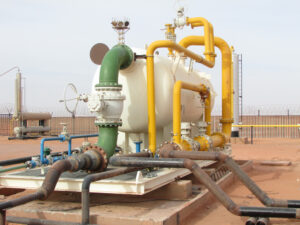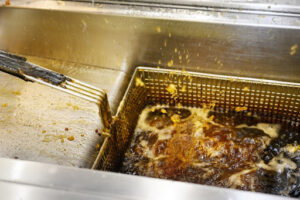Running a restaurant is a nonstop operation. Between managing staff, keeping customers happy, and making sure the food is top-notch, there’s a lot to think about. But one thing that often gets overlooked? The grease trap. It’s not the most glamorous part of the job, but it’s one of the most important.
Grease traps keep fats, oils, and grease (FOG) from clogging your plumbing and causing serious backups. If they’re not cleaned regularly, they can lead to costly repairs, foul odors, and even health code violations. So, how do you know when to schedule a cleaning? Here are five telltale signs your grease trap is overdue for maintenance.
1. Unpleasant Odors That Won’t Go Away
If your kitchen is starting to smell like a mix of old food and sewage, your grease trap might be the culprit. Over time, grease and food particles build up, creating a nasty sludge that produces strong, unpleasant odors. These smells can spread beyond the kitchen, affecting the entire restaurant and even driving customers away.
A clean grease trap shouldn’t smell. If you’re noticing a persistent stink and need grease trap services in Chicago, IL, or one of the surrounding areas, call A&J Sewer Service for assistance.
2. Your Sinks Are Draining Slowly
Slow drainage might not seem like a big deal at first, but it can be one of the warning signs that your grease trap needs cleaning. As grease deposits build up inside your grease trap, they start blocking water flow. This means your sinks take longer to empty, and if left unchecked, you could be dealing with a clogged drain before you know it.
A restaurant’s grease trap is designed to catch grease before it reaches the sewer pipes, but once it’s full, the grease has nowhere to go. The result? Slow drains, standing water in sinks, and possibly even water backing up into your kitchen.
If your sinks aren’t draining as fast as they used to, don’t wait until they stop working to address the issue. Your grease trap needs cleaning before it worsens.
3. Grease in Unwanted Places
One of the biggest red flags that your grease trap needs cleaning is when you start seeing grease where it shouldn’t be. If grease is showing up in your sinks, dishwashing station, or even backing up into the kitchen floor drains, your trap is likely too full to do its job.
A properly maintained grease trap keeps fats, oils, and grease contained. When it’s neglected, all that built-up gunk has to go somewhere, and that somewhere is usually your plumbing system. If you’re spotting grease where it doesn’t belong, it’s time for a cleaning.
4. Increased Pest Activity
Nothing attracts pests faster than food waste and grease buildup. If you’ve noticed an uptick in roaches, flies, or rodents around your kitchen, this can be one of the signs that your grease trap needs cleaning. The grease and food particles that accumulate in an overfilled trap create the perfect feeding ground for unwanted visitors.
Regular cleaning keeps your kitchen cleaner and less appealing to pests. If you’re dealing with more bugs and rodents than usual, it might be time to have your grease trap checked out.
5. Health Code Violations and Compliance Issues
Health inspectors don’t take grease trap maintenance lightly. A dirty or overflowing grease trap can lead to violations. In some cases, local regulations require restaurants to follow a strict cleaning schedule to stay compliant.
If you’ve recently been warned about your grease trap or just want to stay ahead of the game, scheduling routine grease trap cleaning services can save you from unnecessary headaches.
Don’t Forget About Your Used Cooking Oil
Grease traps aren’t the only thing that needs attention in a commercial kitchen. If your restaurant uses a lot of oil, you also need to think about proper disposal. Pouring used oil down the drain can cause even bigger plumbing problems and violate health codes.
Instead, consider turning to A&J Sewer Service for cooking oil collection services in Chicago. We make it easy to get rid of used oil the right way, so you don’t have to worry about it clogging up your drains or harming the environment.
How to Tell If Your Grease Trap Is Full
So, how do you actually know it’s time for a cleaning? Besides the signs we just covered, there are a few easy ways to find grease buildup before it causes problems. Here’s how to tell if your grease trap is full:
- Check the Wastewater Depth: A grease trap has a limit on how much grease it can hold. If you see kitchen waste and grease floating close to the top, it’s time for a cleaning.
- Look for Grease Backing Up Into Sinks: If you see oils or grease deposits around your sink drains, your trap might be full.
- Inspect for Unusual Water Flow: If water seems to be moving more slowly than usual through your water pipes, your grease trap could be clogged.
If you’re experiencing any of these, it’s likely that your grease trap needs cleaning.
Keep Your Grease Trap Clean With A&J Sewer Service!
Your grease trap plays a crucial role in keeping your kitchen’s plumbing system functioning properly. Some common signs that your grease trap needs cleaning are foul smells, clogged drains, and grease backing up into sinks. If you’re not sure how to tell if your grease trap is full, check for a thick grease layer, slow drainage, and wastewater overflow.
If you’ve noticed any of these signs that your grease trap needs cleaning, it’s time to schedule a professional service. A&J Sewer Service offers expert grease trap services in Chicagoland to keep your kitchen running smoothly.
Remember, regular cleaning helps prevent costly repairs, unpleasant odors, and other issues that can disrupt your business. Do you have a dirty grease trap? Give us a call today to schedule a cleaning!



